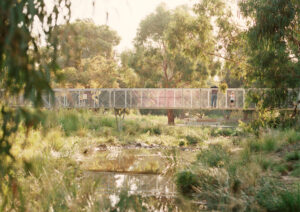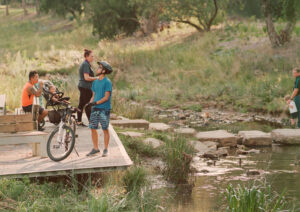How a once Blind Creek can now see daylight
By Gabrielle Stannus
Have you ever thought that your local creek was a little down at heel and that much more could be done to make it a community asset? I spoke with Gail Hall, Melbourne Water’s Healthy Waterways Strategy Co-delivery Coordinator to find out how creeks are being reimagined across that city, and how horticultural and landscape professionals can be part of that transformation.
“Melbourne Water is the waterway manager for the Port Phillip and Western Port region, an area ranging from the forests of the Yarra Ranges down to the fields of Bacchus Marsh,” says Gail. This region covers almost 13,000 square kilometres and contains 25,000 linear kilometres of rivers and creeks, 33 estuaries and 14,000 natural wetlands.
“It has taken our waterways a long time for the impacts of humanisation to be visible and it is going to take a lot of effort, investment and time to reverse those impacts. To manage all of that, we need a long-term strategy,” Gail continues, “The Healthy Waterways Strategy is our collective plan to manage and improve river, estuary and wetland health across Melbourne. It is comprehensive because natural systems are complex. This strategy specifically looks at the science to understand the current state of waterways and the projected impact on them in the future for key threats like climate change and increasing urbanisation.”
“In our increasingly urbanised population, we are going to have to fit more people into our city without losing precious natural areas and places,” says Gail, “We have got to work harder in the places that we have left. Every space must be, or do, more than one thing. Melbourne Water has many pipe tracks and retarding basins that could fulfil more than one function.”
Reimagining Your Creek
Through its Reimagining Your Creek program, Melbourne Water is responding to climate change and urbanisation through community place-making and seeking to make its under-utilised spaces more accessible to local communities. Adopting a co-design approach, Melbourne Water has actively sought and taken on board community aspirations across a number of waterways in its catchments. The program aims to transform stormwater drains and creeks into natural waterways and desirable open spaces, where people can interact with nature in cooler, healthier environments. The result is a hugely successful program that saw Melbourne Water’s project partners, REALMstudios and Alluvium, take out the 2021 AILA National Landscape Architecture Award for Infrastructure and the 2021 AILA Victoria Award of Excellence for Infrastructure.
Blind Creek
One of the first projects realised under the Reimagining Your Creek program was an 800m piped section of Blind Creek in Boronia in the City of Knox in Melbourne’s eastern suburbs. The headwaters of the Blind Creek sub-catchment start in the Dandenong Ranges National Park before entering Dandenong Creek near Jells Park in Wheelers Hill. Melbourne Water worked with REALMstudios and Alluvium to create a desirable open space where people could relax, recreate and interact with nature, whilst the health of local biodiversity, habitat and the waterway itself is improved.

“Blind Creek was literally a grassed area that we ended up having to mow relatively frequently. Its topography meant it was not even suitable for the locals to use to kick a footy or anything like that,” Gail says, “A section of the creek has been transformed into an open space effectively by daylighting, that is, bringing the creek back to the surface. We replaced the piped waterway with an open and flowing channel to restore it to a more natural space. We revegetated the surrounding area to increase and enhance biodiversity and habitat for local flora and fauna. We have also installed park benches and areas for the community to be invited in to relax.”
Other features of the ‘new’ open space at Blind Creek include a crossing bridge and stepping stone crossing points incorporating seating and educative areas that REALMstudios’ designers say are both functional and playful. An ‘urban forest’ now lines the creek’s edge, mitigating against the broader urban heat island effect. Plantings include Yarra Gum (Eucalyptus yarraensis), Prickly Teatree (Leptospermum continentale), Water Ribbons (Cycnogeton procerum syn. Triglochin procerum), Yellow Rush (Juncus flavidus) and the Many-flowered Mat-rush (Lomandra multiflora subsp. multiflora). The result is a more accessible open space where people can interact with nature and each other.
The Reimagining of Blind Creek is continuing this year with further works to be carried out at Lewis Park just upstream of Dandenong Creek and adjacent to the Knox Central Activity Centre. In addition to naturalising the creek, there will be three new wetlands, two harvesting ponds, new paths, a boardwalk and other amenities including community viewing platforms, boardwalks, pedestrian bridges, stepping stone crossings, and benches and tables for the community to enjoy. 676,941 plants will be planted to improve biodiversity outcomes, including 1,700 new trees that will improve shade and cooling. Melbourne Water says that this project will enable around 250 million litres of stormwater to be captured annually to irrigate local sports ovals and community gardens, and improving the quality of water flowing through to Dandenong Creek by removing 764kg of nitrogen from that water.

Liveable Communities, Liveable Waterways
Melbourne Water is looking for partners to help them continue the transformation of waterways across the Port Phillip and Western Port region through the Healthy Waterways Strategy. They have a range of programs supporting riparian restoration on both public and private land that horticultural and landscape professionals may be eligible to apply for on behalf of their clients.
“We have many creeks on private land and those are perhaps the most difficult spaces for Melbourne Water to influence as they are on land where we do not own the surrounding land,” explains Gail, “If you are working along a waterway, you may be eligible for a Liveable Communities, Liveable Waterways grant to support doing this work that may otherwise come out of your client’s budget.”
The Liveable Communities, Liveable Waterways program is open throughout the year to all Melbourne Water customers including landowners, councils and public land managers, school and community groups, universities and research institutions, not-for-profit and collaborative multi-stakeholder groups. Grant themes include but are not limited to ‘Connected habitat and catchments’ and ‘Liveable cities’.
Our Space. Your Place
Other opportunities exist to reimagine the use of open space along Melbourne’s waterways. Our Space. Your Place maps all the land that we manage and provides local government and community with opportunities to use that space either temporarily or longer term,” Gail explains. Under this program, Melbourne Water will consider leasing and/or licensing use of their land for projects that support health and wellbeing. Projects supported by this program have included playgrounds and parks, community gardens and native plantings.
What can you do?
Gail encourages all horticultural and landscape professionals to help Melbourne Water meet the ambitious goals of its Healthy Waterways Strategy.
“We need to consider that we are stewards of land and water when we go to work, designing, building, and planting our urban landscapes. How can the project that you are working on care for country? Habitat fragmentation is one of the key drivers of species extinction along with habitat loss overall. Can your project extend or connect landscapes?” asks Gail.
“Consider how your next project can work with and for the environment. Can you retain natural features rather than flattening topography, for example? Can you reduce non permeable surfaces to a minimum to reduce runoff?”
“Advocates for waterway health in the horticultural and landscape industries are really important because we need multiple, different people saying that this is important to make change,” says Gail, “Because we need our waterways, and our waterways need us.”
For more information about Melbourne Water programs and grants, please visit: www.melbournewater.com.au
Top tips for landscapers and horticulturists working on and for waterways*
How you act
- Consider your role as a steward of land/water. How can you care for country?
- Advocate for and educate clients on the importance of waterway health
Water
- Direct water to landscape, not away from it. Infiltrate into the ground
- Consider alternative water sources to tap
- Design for sustainable water use – the next drought will be a shock to the system
- During construction, prevent sediment and rubbish from entering nearby stormwater drains or waterways, secure light items so they do not become litter
Plants
- Plant more and plant local species, remove pest species, especially near waterways
- Consider future climate for long-term landscapes
- Design for easier maintenance of landscapes and water infrastructure for optimum benefit
Critters
- Design for plant diversity and to attract birds and insects
- Reduce chemical use as much as possible – herbicides, pesticides, and fertilisers
- Link landscapes together where possible
- Do not light upwards – keep the garden dark where possible
* Republished with permission from Melbourne Water
Gabrielle Stannus
Inwardout Studio
M: 0400 431 277
E: gabrielle@inwardoutstudio.com
Main photo: Stepping stone crossing points incorporating seating and educative areas (Image: REALMstudios)

